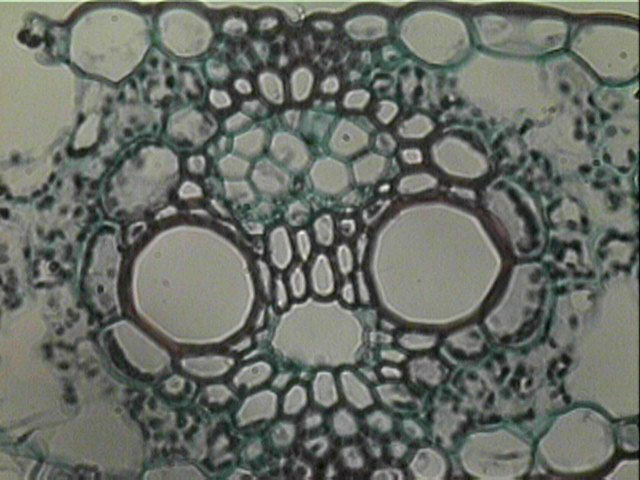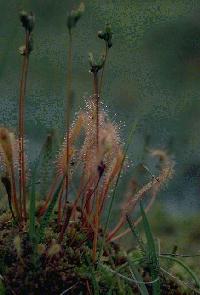|
|
|
|
|
TRANSPIRATION & |
|
|
|
|
Plants need a lot of water. Young Brassica oleracea plants take up an amount of water equal to their shoot weight in about 5 hours - if that applied to me I would have to drink 3 gallons of water an hour to stay alive! Why are they in this position? Photosynthesis requires CO2 ; in order to obtain it stomata must open and the escape of water cannot be avoided. Opening is a blue light response and involves accumulation of sugars, organic acids and potassium to increase osmotic pressure. The guard cells take up water, increasing turgor pressure against the epidermal ground cells. In the dark or under water stress conditions guard cells lose their solutes and stomata close. |
|
|
Rubisco has a low affinity for CO2, so stomata usually have to be wide open in order for photosynthesis to occur. Plants have developed two solutions to this problem. Crassulacean acid metabolism (CAM) Succulent plants (Cactaceae, Crassulaceae and Euphorbiaceae) that grow in dry environments open their stomata at night and combine CO2 with phosphoenol pyruvate (3 carbons) to make malic acid (4 carbons). In the day-time with the stomata closed, malic acid is broken down to pyruvate and CO2, which is fixed by the Calvin cycle into sugars.
|
|
|
Plant type |
First CO2 fixation |
Where/When |
Second CO2 fixation |
Where/When |
|
C3 |
Rubisco |
Mesophyll/Day |
|
|
|
C4 |
PEP carboxylase |
Mesophyll/Day |
Rubisco |
Bundle sheath/Day |
|
CAM |
PEP carboxylase |
Mesophyll/Night |
Rubisco |
Mesophyll/Day |
 Vascular bundle in a corn leaf, surrounded by bundle sheath cells (with dense chloroplasts) and scattered mesophyll cells Water movement
|
|
|
In lab we look at a porous pot pulling water up a glass tube. The pores in the clay pot are just like stomata and the evaporation from these pores is in effect a suction force pulling water up the tube which represents the xylem. The water does not pull back down the tube because surface tension is strong enough to hold the water in the pore. In order to keep its water a leaf cell has to exert a greater suction than evaporation through the stomata. The only way it can do this is through osmosis - having a high enough solute concentration to maintain turgor pressure. |
|
|
If we try to pump water by suction up an open tube we can raise it 32 feet - at that point cohesion is lost and the water column breaks (cavitates). For a long time people doubted that evaporative suction could account for water movement to the top of a tree. When a tree is cut cut down it will often bleed sap from the root, especially in the spring. However this"root pressure" will only push water up a few feet so it is even less satisfactory as an explanation of water movement than evaporative suction. |
|
|
It turns out that water can be pulled up more than 32 feet, provided that it is in a very fine tube. In a capillary tube the adhesion of the water to the walls helps maintain the cohesion of the water column. Xylem contains capillary tubes of this kind and it helps that their cell walls are made of cellulose and other polysaccharides with an affinity for water. Xylem contains two types of water conducting cell: tracheids and vessel elements. The vessels are long (up to several meters) tubes and they are wider than tracheids - this allows for rapid water movement but it also carries a danger of cavitation. Once an air bubble forms in a xylem vessel it knocks out the whole vessel. Tracheids are short narrow cells and offer much more resistance to water flow, but if the water column breaks the problem is restricted to one tracheid. |
|
|
Conifers which have only tracheids cannot achieve such high rates of water transport as dicot trees which have vessels. This restricts their growth and makes them less competitive than flowering plants except in situations where water availability is a problem (juniper scrub, boreal forests). The water pathway in the xylem leads back to the roots - here it passes through living cells - the endodermis, out to the cortex and ultimately the root hairs (or mycorrhizae) in the soil. So transpiration is drawing ultimately on soil water and the water status of the soil is a major factor affecting plant water usage. There are two aspects of this: the amount of water the soil can hold (field capacity) and the amount which is available to the plant. As a plant draws water from a soil it becomes more difficult to take what is left until a point is reached where the soil still contains water but this is unavailable to the plant, the permanent wilting point; the plant will not recover beyond this point. When there is no transpiration, at night or in a decapitated plant the xylem can be at lower water potential than the soil solution because the endodermis pumps ions into the xylem. This can cause osmotic water uptake and a positive pressure from the roots, leading to guttation, the exudation of droplets from the leaves. Inorganic ions do not simply flow with the water, passing into plant roots. They are actively accumulated by epidermal cells, passed through cortical cells and finally secreted by the endodermis cells into the xylem stream. This is the route for all inorganic ions. Apart from the elements that the plant obtains from air and water (C, H, and O) the major nutrients and their form of uptake are: |
|
|
Element |
Ion (charge) |
|
Potassium |
K(+) |
|
Calcium |
Ca(2+) |
|
Magnesium |
Mg(2+) |
|
Nitrogen |
NO3(-) or NH4(+) |
|
Phosphorus |
PO4(3-) |
|
Sulfur |
SO4(2-) |
|
Plant metabolism is adapted to use the minimum amount of nitrogen. The bulk of the dry weight of the plant is carbohydrate rather than protein. However, nitrogen is the nutrient that is most often limiting for plant growth. Some plants have developed ways of overcoming this problem. As we have seen the Fabaceae in general and a few other plants have developed symbiotic relationships with nitrogen fixing bacteria. Others acquire nitrogen by capturing insects in specially modified leaves. |
|
|
Insectivorous plants |
 |
|
Translocation The xylem is essentially a one way street from the roots to the leaves for water and nutrients. The phloem is much more of a two way street for sugars, organic nitrogen compounds and certain (not all) nutrients: the direction of movement is decided by supply and demand or sources and sinks in the commonly used terminology.
|
|
|
|
|
|
Much of the time leaves are the source of sugars produced in photosynthesis and other plant structures, roots, flowers or fruits are the sinks. Sinks may be sites of storage or sites of growth and respiration. In the spring the roots of trees or other underground storage structures of perennials are the source and the developing buds are the sinks. Sieve elements are living cells. Sugars and other compounds are secreted into their cytoplasm; this generates a turgor pressure which causes water to enter the sieve elements from surrounding cells. The water flows through the sieve tube carrying solutes with it. At the other end sink cells unload solutes, maintaining a turgor gradient along the sieve tube that dictates the direction of flow. Potassium, magnesium phosphate and organic nitrogen can also move in the phloem, but calcium is excluded. |
|
|
Copyright © Michael Knee, |